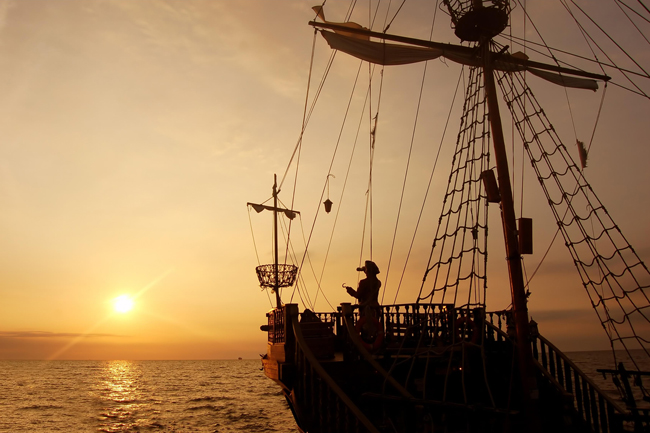
A cross placed where Columbus most likely landed when he discovered San Salvador

A ship arriving to San Salvador

The monument (next to the cross) where Columbus most likely landed when he discovered San Salvador

The Lucayan Indians supposedly thought Columbus and his men were gods.

A pirate ship arriving to San Salvador. There might still be treasure buried on the island.
Some History from San Salvador
Renowned as the first landfall of Christopher Columbus in the West Indies in October 1942, San Salvador ‘Holy Saviour’ was originally called Guanahani by the native Lucayan Indians who inhabited the island at the time of Columbus’ arrival. The island was later taken over by buccaneer George Watling and named Watling’s Island until 1926, when it was renamed San Salvador. Rumors state that pirate treasure is buried on San Salvador.
The Following Information courtesy of Bahamas Information Services, Department of Archives and Local Government
San Salvador is also called the land of lakes and Columbus’ Isle. It is about 12 miles long and five miles wide. Its original name was Guanahani. Later it was called Watling’s Island after George Watling, a noted buccaneer. Until recently, San Salvador was considered one of the least important islands of The Bahamas. However, with the quincentennial celebrations in 1992, San Salvador attracted much attention as it has been for years identified as the first landfall of Christopher Columbus in the New World. He landed at San Salvador on October 12, 1492, and was greeted by the friendly Lucayan Arawaks.
San Salvador has a rich history: the depopulation of its indigenous population by the Spaniards; the use of its inlets by pirates and buccaneers; the coming of the Loyalists and their slaves; the coming of the Americans during the Second World War and its aftermath; and more recently, the advent of the tourist industry.
The San Salvador Museum located in the capital of Cockburn Town, in the ancient 19th century jailhouse and Commissioner’s Office, includes artefacts and replicas highlighting Columbus, the Lucayans, the plantation period and 19th century life on San Salvador. On the outskirts of Cockburn Town is the Heloise Monument, placed there by the yawl Heloise while on an around-the-world cruise in 1951 and is one of four monuments honouring the landfall of Columbus. Another monument is located at Long Bay. A white cross called the Columbus monument was erected in 1956 by Ruth Durlacher Wolper, an artist and writer, and stands next to the Mexican Olympic monument, erected in 1968 to commemorate the landfall of Columbus and the holding of the Olympic Games in the New World (Mexico) that year.
From Ministry of Tourism's Website:
300 TO 400 AD - LUCAYAN/CHRISTOPHER COLUMBUS
As early as 300 to 400 AD, people who came from what is now Cuba (there was no country named Cuba at that time) lived on The Islands Of The Bahamas and relied on the ocean for food. From around 900-1500 AD the Lucayan people settled here. They enjoyed a peaceful way of life and had developed viable political, social and religious systems.
In 1492, Christopher Columbus made landfall in the New World on the island of San Salvador. Inspired by the surrounding shallow sea, he described them as islands of the "baja mar" (shallow sea), which has become The Islands Of The Bahamas. When he arrived, there were about 40,000 Lucayans. Their peaceful nature made the Lucayans easy targets for enslavement however. Within 25 years, all of the Lucayans were wiped out due to the diseases, hardships and slavery endured.
1649 - FIRST SETTLEMENT
English Puritans known as "Eleutheran Adventurers" arrived here in 1649 in search of religious freedom. Instead, they found food shortages. Captain William Sayle sailed to the American colonies for help and received supplies from the Massachusetts Bay Colony. Upon his return, the settlers thanked them by shipping them brasileto wood. The proceeds helped purchase land for what later become Harvard University.
1700 - AGE OF PIRACY
During the late 1600s to early 1700s, many privateers and pirates came here, the most famous one being Blackbeard and Calico Jack. There were also female pirates like Anne Bonny and Mary Read disguised as men.
Our shallow waters and 700 islands made great hiding places for treasure. And our close proximity to well-traveled shipping lanes made for the perfect spot to steal from merchant ships. There are rumors of hidden treasure that still exist today. It is believed that British pirate William Catt buried loot on Cat Island and Sir Henry Morgan, a wealthy privateer, buried treasure throughout our islands.